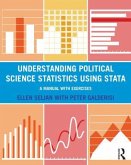Janet B. Johnson (USA University of Delaware), H. T. Reynolds (USA University of Delaware), Jason D. Mycoff (USA University of Delaware)
Political Science Research Methods
Janet B. Johnson (USA University of Delaware), H. T. Reynolds (USA University of Delaware), Jason D. Mycoff (USA University of Delaware)
Political Science Research Methods
- Broschiertes Buch
- Merkliste
- Auf die Merkliste
- Bewerten Bewerten
- Teilen
- Produkt teilen
- Produkterinnerung
- Produkterinnerung
Political Science Research Methods helps students to understand the logic behind research design by guiding them through a step-by-step process that explains when and why a researcher would pursue different kinds of methods.
Andere Kunden interessierten sich auch für
![Political Research: Methods and Practical Skills Political Research: Methods and Practical Skills]() Sandra Halperin (Professor of Professor of International RelationsPolitical Research: Methods and Practical Skills48,99 €
Sandra Halperin (Professor of Professor of International RelationsPolitical Research: Methods and Practical Skills48,99 €![Masters of Mankind Masters of Mankind]() Noam ChomskyMasters of Mankind18,99 €
Noam ChomskyMasters of Mankind18,99 €![Political Science and the Problem of Social Order Political Science and the Problem of Social Order]() Henrik EnrothPolitical Science and the Problem of Social Order32,99 €
Henrik EnrothPolitical Science and the Problem of Social Order32,99 €![Understanding Political Science Statistics using Stata Understanding Political Science Statistics using Stata]() Ellen Seljan (Lewis and USA Clark College)Understanding Political Science Statistics using Stata56,99 €
Ellen Seljan (Lewis and USA Clark College)Understanding Political Science Statistics using Stata56,99 €![Political Science Research in Practice Political Science Research in Practice]() Political Science Research in Practice57,99 €
Political Science Research in Practice57,99 €![Thinking Like a Political Scientist Thinking Like a Political Scientist]() Christopher HowardThinking Like a Political Scientist33,99 €
Christopher HowardThinking Like a Political Scientist33,99 €![Writing a Research Paper in Political Science Writing a Research Paper in Political Science]() Lisa A. BaglioneWriting a Research Paper in Political Science36,99 €
Lisa A. BaglioneWriting a Research Paper in Political Science36,99 €-
-
-
Political Science Research Methods helps students to understand the logic behind research design by guiding them through a step-by-step process that explains when and why a researcher would pursue different kinds of methods.
Hinweis: Dieser Artikel kann nur an eine deutsche Lieferadresse ausgeliefert werden.
Hinweis: Dieser Artikel kann nur an eine deutsche Lieferadresse ausgeliefert werden.
Produktdetails
- Produktdetails
- Verlag: SAGE Publications Inc
- 9 Revised edition
- Seitenzahl: 400
- Erscheinungstermin: 15. Oktober 2019
- Englisch
- Abmessung: 190mm x 236mm x 21mm
- Gewicht: 722g
- ISBN-13: 9781544331430
- ISBN-10: 1544331436
- Artikelnr.: 55172656
- Herstellerkennzeichnung
- Libri GmbH
- Europaallee 1
- 36244 Bad Hersfeld
- gpsr@libri.de
- Verlag: SAGE Publications Inc
- 9 Revised edition
- Seitenzahl: 400
- Erscheinungstermin: 15. Oktober 2019
- Englisch
- Abmessung: 190mm x 236mm x 21mm
- Gewicht: 722g
- ISBN-13: 9781544331430
- ISBN-10: 1544331436
- Artikelnr.: 55172656
- Herstellerkennzeichnung
- Libri GmbH
- Europaallee 1
- 36244 Bad Hersfeld
- gpsr@libri.de
Janet Buttolph Johnson is associate professor of political science and international relations at the University of Delaware, where she specializes in public policy, state and local politics, and environmental policy and politics.
Tables, Figures, and Features Preface About the Authors Chapter 1
Introduction Research on Income Inequality Politics and the Gender Gap The Case of Italian (Non) Tax Compliance Protests and Repression in New Democracies The Observer Effect in International Politics: Evidence from a Natural Experiment Conclusion Terms Introduced Chapter 2
The Empirical Approach to Political Science Elements of Empiricism The Importance of Theory A Brief Overview of the Empirical Research Process Reactions to the Empirical Approach: Practical Objections Competing Points of View Conclusion Terms Introduced Suggested Readings Chapter 3
Beginning the Research Process: Identifying a Research Topic, Developing Research Questions, and Reviewing the Literature Specifying the Research Question Sources of Ideas for Research Topics Why Conduct a Literature Review? Collecting Sources for a Literature Review Writing a Literature Review Anatomy of a Literature Review Conclusion Terms Introduced Suggested Readings Chapter 4
The Building Blocks of Social Scientific Research: Hypotheses, Concepts, Variables, and Measurement Proposing Explanations Formulating Hypotheses Defining Concepts Devising Measurement Strategies The Accuracy of Measurements The Precision of Measurements Conclusion Terms Introduced Suggested Readings Chapter 5
Sampling The Basics of Sampling How Do We Use a Sample to Learn About a Population? Sampling Methods Types of Samples Conclusion Terms Introduced Suggested Readings Chapter 6
Research Design: Establishing Causation Verifying Causal Assertions Qualitative and Quantitative Methods and Analysis: Causes-of-Effects and Effects-of-Causes Approaches Conclusion Terms Introduced Suggested Readings Chapter 7
Qualitative Research: Case Study Designs Case Study Methods Case Study Types Using Cases to Explore Causal Mechanisms: Process Tracing Generalizing from Cases Studies Conclusion Terms Introduced Suggested Readings Chapter 8
Making Empirical Observations: Qualitative Analysis Types of Data and Collection Techniques Data Collection in Qualitative Research Conclusion Terms Introduced Suggested Readings Chapter 9
Quantitative Research Designs Randomized Experimental Designs Natural Experiments Nonrandomized Designs: Quasi-Experiments Observational Studies Conclusion Terms Introduced Suggested Readings Chapter 10
Quantitative Methods The Wide Variety of Quantitative Projects Sources of Data for Quantitative Studies Data Management Ethical Concerns with Quantitative Methods Conclusion Terms Introduced Suggested Readings Chapter 11
Making Sense of Data: First Steps The Data Matrix Descriptive Statistics Graphs for Presentation and Exploration Conclusion Terms Introduced Suggested Readings Chapter 12
Testing Relationships The Normal Distribution and z Scores Confidence Intervals Hypothesis Testing Testing a Relationship with Two Samples Conclusion Terms Introduced Suggested Readings Chapter 13
Analyzing Relationships for Categorical Data The Basics of Identifying and Measuring Relationships Table Summaries of Categorical Variable Associations Measuring Strength of Relationships in Tables Measures of Association: Statistics for Reporting the Strength of Relationships in Tables Chi Square Test for Independence Multivariate Analysis of Categorical Data Analysis of Variance: Analyzing the Difference between Means for More Than Two Means Conclusion Terms Introduced Suggested Readings Chapter 14
Regression Logic of Regression Minimizing the Sum of the Squared Error The Linear Regression Model Maximum Likelihood Models for Dichotomous Dependent Variables Conclusion Terms Introduced Suggested Readings Chapter 15
The Research Report: An Annotated Example Annotated Research Report Example Appendixes Appendix A: Normal Curve Tail Probabilities Appendix B: Critical Values from t Distribution Appendix C: Chi-Squared Distribution Values for Various Right-Tail Probabilities Appendix D: F Distribution Glossary Index
Introduction Research on Income Inequality Politics and the Gender Gap The Case of Italian (Non) Tax Compliance Protests and Repression in New Democracies The Observer Effect in International Politics: Evidence from a Natural Experiment Conclusion Terms Introduced Chapter 2
The Empirical Approach to Political Science Elements of Empiricism The Importance of Theory A Brief Overview of the Empirical Research Process Reactions to the Empirical Approach: Practical Objections Competing Points of View Conclusion Terms Introduced Suggested Readings Chapter 3
Beginning the Research Process: Identifying a Research Topic, Developing Research Questions, and Reviewing the Literature Specifying the Research Question Sources of Ideas for Research Topics Why Conduct a Literature Review? Collecting Sources for a Literature Review Writing a Literature Review Anatomy of a Literature Review Conclusion Terms Introduced Suggested Readings Chapter 4
The Building Blocks of Social Scientific Research: Hypotheses, Concepts, Variables, and Measurement Proposing Explanations Formulating Hypotheses Defining Concepts Devising Measurement Strategies The Accuracy of Measurements The Precision of Measurements Conclusion Terms Introduced Suggested Readings Chapter 5
Sampling The Basics of Sampling How Do We Use a Sample to Learn About a Population? Sampling Methods Types of Samples Conclusion Terms Introduced Suggested Readings Chapter 6
Research Design: Establishing Causation Verifying Causal Assertions Qualitative and Quantitative Methods and Analysis: Causes-of-Effects and Effects-of-Causes Approaches Conclusion Terms Introduced Suggested Readings Chapter 7
Qualitative Research: Case Study Designs Case Study Methods Case Study Types Using Cases to Explore Causal Mechanisms: Process Tracing Generalizing from Cases Studies Conclusion Terms Introduced Suggested Readings Chapter 8
Making Empirical Observations: Qualitative Analysis Types of Data and Collection Techniques Data Collection in Qualitative Research Conclusion Terms Introduced Suggested Readings Chapter 9
Quantitative Research Designs Randomized Experimental Designs Natural Experiments Nonrandomized Designs: Quasi-Experiments Observational Studies Conclusion Terms Introduced Suggested Readings Chapter 10
Quantitative Methods The Wide Variety of Quantitative Projects Sources of Data for Quantitative Studies Data Management Ethical Concerns with Quantitative Methods Conclusion Terms Introduced Suggested Readings Chapter 11
Making Sense of Data: First Steps The Data Matrix Descriptive Statistics Graphs for Presentation and Exploration Conclusion Terms Introduced Suggested Readings Chapter 12
Testing Relationships The Normal Distribution and z Scores Confidence Intervals Hypothesis Testing Testing a Relationship with Two Samples Conclusion Terms Introduced Suggested Readings Chapter 13
Analyzing Relationships for Categorical Data The Basics of Identifying and Measuring Relationships Table Summaries of Categorical Variable Associations Measuring Strength of Relationships in Tables Measures of Association: Statistics for Reporting the Strength of Relationships in Tables Chi Square Test for Independence Multivariate Analysis of Categorical Data Analysis of Variance: Analyzing the Difference between Means for More Than Two Means Conclusion Terms Introduced Suggested Readings Chapter 14
Regression Logic of Regression Minimizing the Sum of the Squared Error The Linear Regression Model Maximum Likelihood Models for Dichotomous Dependent Variables Conclusion Terms Introduced Suggested Readings Chapter 15
The Research Report: An Annotated Example Annotated Research Report Example Appendixes Appendix A: Normal Curve Tail Probabilities Appendix B: Critical Values from t Distribution Appendix C: Chi-Squared Distribution Values for Various Right-Tail Probabilities Appendix D: F Distribution Glossary Index
Tables, Figures, and Features Preface About the Authors Chapter 1
Introduction Research on Income Inequality Politics and the Gender Gap The Case of Italian (Non) Tax Compliance Protests and Repression in New Democracies The Observer Effect in International Politics: Evidence from a Natural Experiment Conclusion Terms Introduced Chapter 2
The Empirical Approach to Political Science Elements of Empiricism The Importance of Theory A Brief Overview of the Empirical Research Process Reactions to the Empirical Approach: Practical Objections Competing Points of View Conclusion Terms Introduced Suggested Readings Chapter 3
Beginning the Research Process: Identifying a Research Topic, Developing Research Questions, and Reviewing the Literature Specifying the Research Question Sources of Ideas for Research Topics Why Conduct a Literature Review? Collecting Sources for a Literature Review Writing a Literature Review Anatomy of a Literature Review Conclusion Terms Introduced Suggested Readings Chapter 4
The Building Blocks of Social Scientific Research: Hypotheses, Concepts, Variables, and Measurement Proposing Explanations Formulating Hypotheses Defining Concepts Devising Measurement Strategies The Accuracy of Measurements The Precision of Measurements Conclusion Terms Introduced Suggested Readings Chapter 5
Sampling The Basics of Sampling How Do We Use a Sample to Learn About a Population? Sampling Methods Types of Samples Conclusion Terms Introduced Suggested Readings Chapter 6
Research Design: Establishing Causation Verifying Causal Assertions Qualitative and Quantitative Methods and Analysis: Causes-of-Effects and Effects-of-Causes Approaches Conclusion Terms Introduced Suggested Readings Chapter 7
Qualitative Research: Case Study Designs Case Study Methods Case Study Types Using Cases to Explore Causal Mechanisms: Process Tracing Generalizing from Cases Studies Conclusion Terms Introduced Suggested Readings Chapter 8
Making Empirical Observations: Qualitative Analysis Types of Data and Collection Techniques Data Collection in Qualitative Research Conclusion Terms Introduced Suggested Readings Chapter 9
Quantitative Research Designs Randomized Experimental Designs Natural Experiments Nonrandomized Designs: Quasi-Experiments Observational Studies Conclusion Terms Introduced Suggested Readings Chapter 10
Quantitative Methods The Wide Variety of Quantitative Projects Sources of Data for Quantitative Studies Data Management Ethical Concerns with Quantitative Methods Conclusion Terms Introduced Suggested Readings Chapter 11
Making Sense of Data: First Steps The Data Matrix Descriptive Statistics Graphs for Presentation and Exploration Conclusion Terms Introduced Suggested Readings Chapter 12
Testing Relationships The Normal Distribution and z Scores Confidence Intervals Hypothesis Testing Testing a Relationship with Two Samples Conclusion Terms Introduced Suggested Readings Chapter 13
Analyzing Relationships for Categorical Data The Basics of Identifying and Measuring Relationships Table Summaries of Categorical Variable Associations Measuring Strength of Relationships in Tables Measures of Association: Statistics for Reporting the Strength of Relationships in Tables Chi Square Test for Independence Multivariate Analysis of Categorical Data Analysis of Variance: Analyzing the Difference between Means for More Than Two Means Conclusion Terms Introduced Suggested Readings Chapter 14
Regression Logic of Regression Minimizing the Sum of the Squared Error The Linear Regression Model Maximum Likelihood Models for Dichotomous Dependent Variables Conclusion Terms Introduced Suggested Readings Chapter 15
The Research Report: An Annotated Example Annotated Research Report Example Appendixes Appendix A: Normal Curve Tail Probabilities Appendix B: Critical Values from t Distribution Appendix C: Chi-Squared Distribution Values for Various Right-Tail Probabilities Appendix D: F Distribution Glossary Index
Introduction Research on Income Inequality Politics and the Gender Gap The Case of Italian (Non) Tax Compliance Protests and Repression in New Democracies The Observer Effect in International Politics: Evidence from a Natural Experiment Conclusion Terms Introduced Chapter 2
The Empirical Approach to Political Science Elements of Empiricism The Importance of Theory A Brief Overview of the Empirical Research Process Reactions to the Empirical Approach: Practical Objections Competing Points of View Conclusion Terms Introduced Suggested Readings Chapter 3
Beginning the Research Process: Identifying a Research Topic, Developing Research Questions, and Reviewing the Literature Specifying the Research Question Sources of Ideas for Research Topics Why Conduct a Literature Review? Collecting Sources for a Literature Review Writing a Literature Review Anatomy of a Literature Review Conclusion Terms Introduced Suggested Readings Chapter 4
The Building Blocks of Social Scientific Research: Hypotheses, Concepts, Variables, and Measurement Proposing Explanations Formulating Hypotheses Defining Concepts Devising Measurement Strategies The Accuracy of Measurements The Precision of Measurements Conclusion Terms Introduced Suggested Readings Chapter 5
Sampling The Basics of Sampling How Do We Use a Sample to Learn About a Population? Sampling Methods Types of Samples Conclusion Terms Introduced Suggested Readings Chapter 6
Research Design: Establishing Causation Verifying Causal Assertions Qualitative and Quantitative Methods and Analysis: Causes-of-Effects and Effects-of-Causes Approaches Conclusion Terms Introduced Suggested Readings Chapter 7
Qualitative Research: Case Study Designs Case Study Methods Case Study Types Using Cases to Explore Causal Mechanisms: Process Tracing Generalizing from Cases Studies Conclusion Terms Introduced Suggested Readings Chapter 8
Making Empirical Observations: Qualitative Analysis Types of Data and Collection Techniques Data Collection in Qualitative Research Conclusion Terms Introduced Suggested Readings Chapter 9
Quantitative Research Designs Randomized Experimental Designs Natural Experiments Nonrandomized Designs: Quasi-Experiments Observational Studies Conclusion Terms Introduced Suggested Readings Chapter 10
Quantitative Methods The Wide Variety of Quantitative Projects Sources of Data for Quantitative Studies Data Management Ethical Concerns with Quantitative Methods Conclusion Terms Introduced Suggested Readings Chapter 11
Making Sense of Data: First Steps The Data Matrix Descriptive Statistics Graphs for Presentation and Exploration Conclusion Terms Introduced Suggested Readings Chapter 12
Testing Relationships The Normal Distribution and z Scores Confidence Intervals Hypothesis Testing Testing a Relationship with Two Samples Conclusion Terms Introduced Suggested Readings Chapter 13
Analyzing Relationships for Categorical Data The Basics of Identifying and Measuring Relationships Table Summaries of Categorical Variable Associations Measuring Strength of Relationships in Tables Measures of Association: Statistics for Reporting the Strength of Relationships in Tables Chi Square Test for Independence Multivariate Analysis of Categorical Data Analysis of Variance: Analyzing the Difference between Means for More Than Two Means Conclusion Terms Introduced Suggested Readings Chapter 14
Regression Logic of Regression Minimizing the Sum of the Squared Error The Linear Regression Model Maximum Likelihood Models for Dichotomous Dependent Variables Conclusion Terms Introduced Suggested Readings Chapter 15
The Research Report: An Annotated Example Annotated Research Report Example Appendixes Appendix A: Normal Curve Tail Probabilities Appendix B: Critical Values from t Distribution Appendix C: Chi-Squared Distribution Values for Various Right-Tail Probabilities Appendix D: F Distribution Glossary Index








